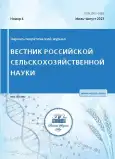Influence of mineral fertilizer on soil microflora
- Authors: Zamyatin S.A1, Maksimova R.B1
-
Affiliations:
- Mari Agricultural Research Institute - Mari Agricultural Research Institute - Branch of Federal Agricuctural Research Center of the North-East named N.V. Rudnitsky
- Issue: No 4 (2023)
- Pages: 68-71
- Section: Articles
- URL: https://journals.rcsi.science/2500-2082/article/view/141512
- DOI: https://doi.org/10.31857/2500-2082/2023/4/68-71
- EDN: https://elibrary.ru/DLRLNN
- ID: 141512
Cite item
Full Text
Abstract
About the authors
S. A Zamyatin
Mari Agricultural Research Institute - Mari Agricultural Research Institute - Branch of Federal Agricuctural Research Center of the North-East named N.V. Rudnitsky
Email: zamyatin.ser@mail.ru
R. B Maksimova
Mari Agricultural Research Institute - Mari Agricultural Research Institute - Branch of Federal Agricuctural Research Center of the North-East named N.V. Rudnitsky
References
- Аристовская Т.В., Чугунова М.В. Экспресс-метод определения биологической активности почв // Почвоведение. 1989. №11. С.142-147.
- Берестецкий О.А., Торжевский В.И., Мочалов Ю.М. Особенности микрофлоры дерново-подзолистой почвы при бессменном выращивании сельскохозяйственных растений и в севообороте // Микробиология. 1976. Т.45. Вып.4. С.710-716.
- Доспехов Б.А. Методы полевого опыта с основами статистической обработки / Изд-е 5-е, дополненное и переработанное. М.: Агропромиздат, 1985. 351 с.
- Дридигер В.К., Стукалов Р.С., Гаджиумаров Р.Г. Экономическая эффективность севооборотов при возделывании полевых культур без обработки почвы // Сельскохозяйственный журнал. 2019. №4 (12). С. 6-12. doi: 10.25930/0372-3054/001.4.12.2019.
- Замятин С.А., Максимова Р.Б. Влияние культур севооборотов на биологическую активность почвы. Зерновое хозяйство России. 2021. №4 С. 39-44. doi: 10.31367/2079-8725-2021-76-4-39-44.
- Карабутов А.П., Соловиченко В.Д., Никитин В.В. Воспроизводство плодородия почв, продуктивность и энергетическая эффективность севооборотов // Земледелие. 2019. № 2. С. 3-7. DOI:10. 24411/0044-3913-2019-10201.
- Козлова Л.М., Носкова Е.Н., Попов Ф.А. Оптимизация полевых севооборотов, как фактор сохранения почвенного плодородия и экологизации земледелия // Агроэкология. 2020. № 3. С 147-153. doi: 10.25750/1995-4301-2020-147-153.
- Кузминых А.Н. Влияние видов паров на микробиологическую активность почвы // Аграрная наука Евро-Северо-Востока. 2012. № 5 (30). С. 44-46.
- Мишустин Е.Н., Емцев В.Т., Микробиология. Изд. 3-е, перераб. и доп. М.: Агропромиздат, 1987. 368 с.
- Никитин. В.В., Соловниченко В.Д., Навальнев В.В., Карабутов А.П. Влияние севооборотов, способов обработки почв и удобрений на изменение органического вещества в черноземе типичном // Агрохимия. 2017. №2. С. 233.
- Общия Е.Н. Хрипунов А.И. Целлюлозоразлагающая активность почвы в условиях склоновых земель ландшафтов как один из элементов ее биологической активности // Сельскохозяйственный журнал. 2019. №2 (12). С.25-28. doi: 10.25930/004.2.12.2019.
- Применение метода льняных полотен для учета биологической активности почвы в условиях техногенного загрязнения / Экологическая безопасность в АПК. РЖ. М., 2008. №1. 18 с.
- Саетгалиева Г. Э. Ферментативная активность почвы как показатель ее плодородия // Молодой ученый. 2014. С. 277-278.
- Bardgett R.D., Mommer L., De Vries F.T. Going underground: root traits as drivers of ecosystem processes//Trends Ecol. Evol. 2014. № 29. P. 692-699. doi: 10.1016/j.tree.2014.10.006.
- Bisen N., Rahangdale C.P. Crop residues management option for sustainable soil health in rise-wheat system: a review // International Journal of Chemical Studies. 2017. №5 (4). PP. 1038-1042. Available at: https://www.researchgate.net/publication/318959582 residues management option for sustainable soil health in rise-wheat sustem a review (дата обращения: 10. 01. 2023).
- Hirte J. et al. Overestimation of crop root biomass in field experiments due to extraneous organic matter // Front Plant Sci. 2017. № 8. p. 284. doi: 10.3389/fpls.2017. 00284.
- Philippot L., Raaijmakers J.M., Lemanceau P., Van der Putten W.H. Going back to the roots: the microbial ecology of the rhizosphere // Nat. Rev. Microbiol. 2013. №11. P. 789-799. doi: 10.1038/nrmicro3109.
Supplementary files










